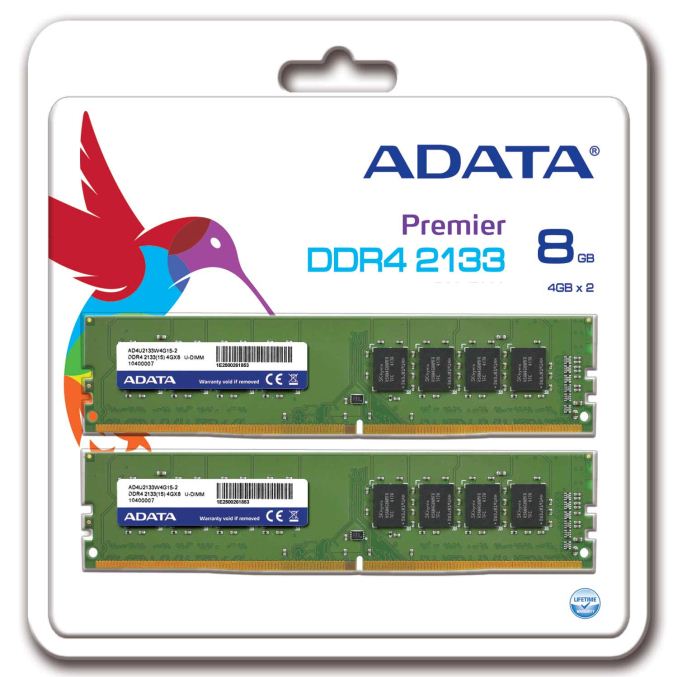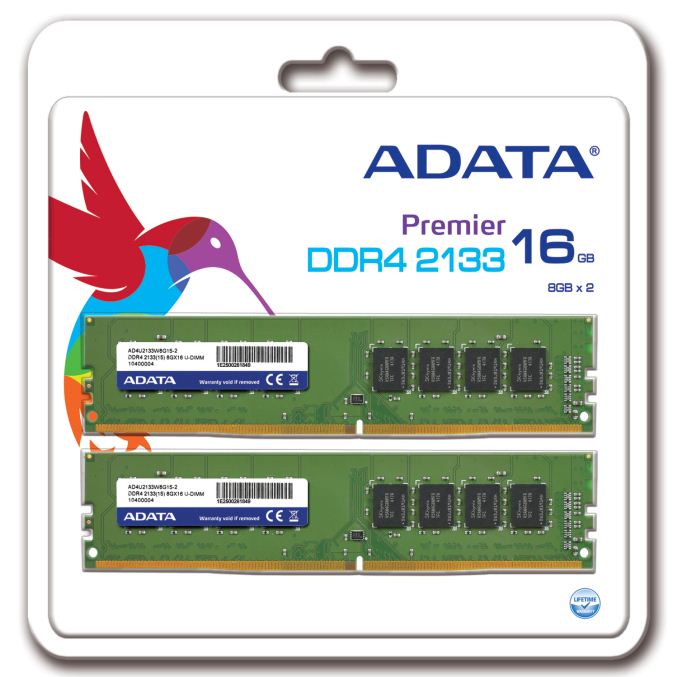ADATA Formally Announces DDR4-2133 CL15 UDIMMs
by Ian Cutress on July 31, 2014 5:17 PM EST
One of the hot topics in computer upgrades for the next couple of years is going to be the move to DDR4. Intel has already announced that the Haswell-E / X99 platform will be based on DDR4, and we can only assume that other future platforms will use it as well. The shift from DDR3 to DDR4 is a the big jump for DRAM manufacturers as well, shifting gears to the new product and maintaining stocks of both for the meantime. ADATA is one of the first to officially launch their consumer memory, their Premier line of DDR4.
JEDEC specifications have the DDR4 base frequency at 2133 MHz with sub-timing latencies of 15-15-15 at 1.2 volts. This is where ADATA will be positioning their first DDR4 modules in the market, and we can assume that others will as well until higher frequency parts are binned. Compare this to the rate of DDR3-2133, which is often at 10-12-12 timings or similar, but uses 1.65 volts, and typically comes with heatsinks.
Because we are far from the launch of a consumer platform for DDR4, as one might expect this comes across more as a paper launch. ADATA in the past typically publishes a PR about new memory about two weeks before it goes on the market, and I am asking about pricing which was not mentioned. Given the pictures we received with the modules, it would seem that 4GB and 8GB modules will be first to market for DDR4 unless another DRAM manufacturer has something up its sleeve.
Source: ADATA














28 Comments
View All Comments
MrSpadge - Friday, August 1, 2014 - link
As others have said, it should quickly get better. But there's more: DDR4 is supposed to be a bit faster at similar specs due to improved efficiency. Let's see how this works out!Furthermore: this is for businesses who wouldn't run current Intels at anything higher than DDR3-1600, because they're not specified for anything faster. and if they can keep up DDR4-2133 15-15-15 for 16 GB modules it's actually not that bad.
Impulses - Thursday, July 31, 2014 - link
Pricing's the most important part, the cost will be absorbed by system integrators regardless but whether there's price parity or an increase will determine how quickly enthusiasts adopt a platform that uses DDR4.I imagine everyone will soon slap spreaders on modules regardless of whether it's needed or not, tho if you're making bland green DIMMs you might as well.
Assimilator87 - Friday, August 1, 2014 - link
I do love Geil's Black Dragon series for memory without heatspreaders.Mr Perfect - Thursday, July 31, 2014 - link
They don't really need the heatsinks though, do they? I was under the impression they're usually there for the aesthetics.
CaedenV - Thursday, July 31, 2014 - link
performance memory at 1600+ could probably use at least a basic spreader, especially when you don't know what kind of environment it is going to be installed in. I am a firm believer in AC in by house, but some crazy people somehow enjoy 80*f temps, and computer parts may not deal so well for them. So better safe than sorry I suppose.Still, with modern processing, lower voltage, and a cycle time, I can't imagine these getting all that warm.
Peeping Tom - Thursday, July 31, 2014 - link
Not unless they're overclocked beyond spec IMOsemyon95 - Thursday, July 31, 2014 - link
These are honestly just garbage sticks. I see no reason anyone would buy DDR4 sticks that:1. have only 8 GB for a DDR4 set
2. provide only 2133 MHz bandwidth for DDR4
3. add to this worst you can get CL15 timings
4. also these are not even LPDDR4/notebook oriented modules so you can't excuse the specs
What we have here is a product that is targeted at desktops, but every DDR3 2133 set outperforms it. The only advantage of this set -- low voltage -- doesn't matter for a desktop PC.
Kjella - Friday, August 1, 2014 - link
Maybe because hammering those DDR3 2133 set sticks into a platform that uses DDR4 won't work? Considering a Haswell-E here but might skimp on the RAM to buy a decent set later.Peeping Tom - Thursday, July 31, 2014 - link
Please don't drag out the latency improvements until we're on the cusp of DDR5/Nextgen.DanNeely - Friday, August 1, 2014 - link
If it was possible to make DRAM itself dramatically faster, we'd never have gone down the whole DDR1/2/3/4 cycle with each generation roughly corresponding to doubling the databus speed and doubling the on-dimm parallelism to feed it. PC-133, DDR1-266, DDR2-533, DDR3-1066, and DDR4-2133 all have the dram running at the same speed; and just use faster/more parallel controllers to read/write to more locations within the ram chips at once.This is also why we should expect to see DDR4 speeds ramp up fairly quickly; as the engineers get more practice in building faster controllers; the actual dram has plenty of headroom before it catches up with the speeds at which it's been made to operate in DDR3.